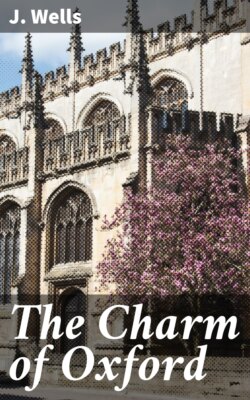Читать книгу The Charm of Oxford - J. O. Wells - Страница 8
THE BROAD STREET
Оглавление"Ye mossy piles of old munificence,
At once the pride of learning and defence."
J. WARTON,Triumph of Isis.
The east side of the University buildings proper was shown in the last picture (Plate III); in the following (Plate IV), the north side of the same block is seen. The old University "schools" lay just inside the city wall, and Broad Street, which is there represented, occupies the site of the ditch, which ran on the north of the wall. This picture is a fitting supplement to the last, for the Sheldonian Theatre on the right of it and the Clarendon Building in the background may claim rank even with the Bodleian and the Radcliffe as the University's special buildings.
The Sheldonian celebrated its two hundred and fiftieth anniversary only last year (1919), when the music which had been performed at its opening was performed once more. It is a building interesting from many points of view. Architecturally it marks the first complete flowering of the genius of Sir Christopher Wren. He was only thirty-seven when it was completed, and had been previously known rather as a man of science than as an architect; he was Oxford's Professor of Astronomy; but Archbishop Sheldon chose him to build a worthy meeting place for his University, even as at the same time he was being called by the king to prepare plans for rebuilding London after the Great Fire.
The very existence of the Sheldonian marks the development of University ideas. The simple piety—or was it the worldliness?—of Pre-Reformation Oxford had seen nothing unsuitable in the ceremonies of graduate Oxford and the ribaldries of undergraduate Oxford taking place in the consecrated building of St. Mary's; but the more sober genius of Anglicanism was shocked at these secular intrusions, and Sheldon provided his University with a worthy home, where its great functions have been performed ever since.
The building is a triumph of construction; it is doubtful if so large an unsupported roof can be found elsewhere; but Wren is not to be held responsible for the outside ugly flat roof, which was put on 100 years ago, because it was said, quite falsely, that Wren's roof was unsafe. That architect had set himself the problem of getting the greatest number of people into the space at his disposal, and he managed to fit in a building that will hold 1,500. It was also intended for the Printing Press of the University, but was only used in that way for a short time, as in 1713 Sir John Vanbrugh put up the Clarendon Building, to house this department of University activity. The "heaviness" of Vanbrugh's buildings was a jest even in his own time; someone wrote as an epitaph for him
"Lie heavy on him. Earth, for he
Laid many a heavy load on thee."
Blenheim Palace, his greatest work, is indeed a "heavy load." But the same criticism can hardly be brought against the columned portico, which forms a fine ending for the Broad Street. Vanbrugh's building was superseded in its turn, when the increasing business of the Oxford Printing Press was moved to the present building in 1830.
